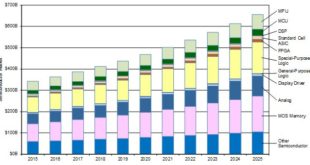Semiconductors are materials that have a conductivity between conductors and insulators. They can be pure elements, silicon or germanium or compounds; gallium, arsenide or cadmium selenide. Semiconductor Chips are the basic building blocks that serve as the heart and brain of all modern electronics and information and communications technology products. …
Read More »Large Global semiconductor market growth driven by consumer electronics, cloud computing, internet-connected devices (IoT), and Artificial Intelligence
The semiconductor industry is the aggregate of companies engaged in the design and fabrication of semiconductors and semiconductor devices, such as transistors and integrated circuits. The semiconductor industry is in turn the driving force behind the wider electronics industry. The amazing development of electronics in the past decades, from early …
Read More »US Army Medical Modernization Strategy(AMMS) to counter future medical threats through disruptive technologies
As the Army charts a course to modernize its force by 2035 with a focus on multi-domain operations, the service is also looking to fundamentally transform its medical capabilities to take advantage of and move at the pace of technological advancements. The Army must modernize its medical formations and capabilities …
Read More »Quantum secure direct communication (QSDC)
Quantum communication refers to a quantum information exchange that uses photons as quantum information carriers over optical fibre or free-space channels. Today, quantum data transfer rates remain quite low, and so communicating entire messages is not yet practical. Instead, Quantum Cryptography or Quantum key distribution (QKD) is being used …
Read More »Laser 3D scanning for fast prototyping of Military systems, reverse engineering, virtual reality, maintenance support and quality control
3D laser scanning is a way to capture a physical object’s exact size and shape into the computer world as a digital 3-dimensional representation. 3D Laser Scanning is a non-contact, non-destructive technology that digitally captures the shape and structure of physical objects in a faster and more accurate way using …
Read More »Remote Security Assessment System (RSAS)
Network vulnerabilities are an increasingly common issue in today’s highly complex computing environments. With exploit attacks appearing faster than ever before, it has become significantly more challenging for organizations to protect against attacks. Only if users could discover these vulnerabilities in their network and proactively get ready before attackers take action, can the losses …
Read More »Modeling and Simulation are critical enablers for military training, analysis, decision-making and capability development
Conflicts unfold at an unprecedented rate and things can change in days if not hours, the amount of data available is overwhelming in both volume and complexity. We need new tools to make sense of it all. This is against a backdrop of rising costs and financial pressures, and so …
Read More »Threat of Quantum computer to Blockchain , Researchers propose Quantum Resistant Ledger (QRL) and Quantum blockchain
Blockchain, is a growing list of records, called blocks, which are linked using cryptography. Blockchains which are readable by the public are widely used by cryptocurrencies. Private blockchains have been proposed for business use. Blockchain a transformative decentralized digital currency, a secure payment platform free from government interference, is being considered …
Read More »Wireless and Satellite Network testing tools QXDM, Speedtest, xcal/qualipoc, drive-test tools
5G will enable a new set of services, not only for human users but also for industrial and automotive purposes. Key factors for acceptance and use are ultra-high reliability and real-time interaction capability. For those future applications, it is key to measure and rate the interactivity of a network and …
Read More »Network simulation Software for Wireless Networks including 5G
In computer network research, network simulation is a technique whereby a software program replicates the behavior of a real network. A network simulator is a software program that can predict the performance of a computer network or a wireless communication network. Since communication networks have become too complex for …
Read More » International Defense Security & Technology Your trusted Source for News, Research and Analysis
International Defense Security & Technology Your trusted Source for News, Research and Analysis



